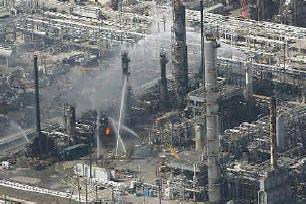User:Milton Beychok/Sandbox
Process Safety Management (PSM) is a regulation promulgated by the U.S. Occupational Safety and Health Administration (OSHA) in 1992.[1] It is intended to prevent or minimize the consequences of catastrophic releases of toxic, reactive, flammable, or explosive "Highly Hazardous Chemicals" (HHCs) from processes.[2]
The PSM regulation intends to accomplish its goal by requiring a comprehensive management program integrating technologies, procedures, and management practices.
Rationale
The primary motivation for the promulgation of the OSHA PSM regulation was to prevent the occurrence of such disasters as the one in 1984 at Bhopal, India which resulted in more than 2,000 deaths, as well as such incidents that occurred in four chemical plants within the United States during the period of 1989 to 1991 and which resulted in 51 deaths and 181 injured. While these incidents were highly publicized and drew national attention, many other less publicized hazardous chemical releases also occurred.[3]
Incidents still continue to occur in various industries that use highly hazardous chemicals. Regardless of the industry that uses these highly hazardous chemicals, there is a potential for an accidental release any time they are not properly controlled. To help assure safe and healthy workplaces, OSHA issued the PSM regulation which contains requirements for the management and control of the dangers associated with processes using highly hazardous chemicals.[4]
Definitions
Process:
Any activity or combination of activities including any use, storage, manufacturing, handling or the on-site movement of Highly Hazardous Chemicals (HHCs). A process includes any separate vessels or any group of interconnected vessels which could be involved in a potential release of a Highly Hazardous Chemical.
Facility:
The buildings, containers or equipment which contain a process.
Highly Hazardous Chemical:
Any substance having toxic, reactive, flammable, or explosive properties. A list of 137 such substances is included in Appendix B of the PSM regulation.
Threshold quantity:
The threshold quantity (TQ) of a HHC is that quantity at or above which the HHC has a potential for a catastrophic release. The list of HHCs in Appendix B of the PSM regulation includes the TQ of each listed HHC.
Catastrophic release:
A major uncontrolled release, fire, or explosion, involving one or more HHCs, that presents a serious danger to employees in the workplace.
Process hazard analysis:
A process hazard analysis (PHA) is
Applicability and compliance
The PSM regulation applies to a any process facility which contains a threshold quantity or greater amount of a toxic or reactive HHC as specified in Appendix A of the regulation. It also applies to any facility containing 10,000 pounds or greater amounts of flammable liquids and gases and to the process activity of manufacturing explosives and pyrotechnics.
The regulation specifically exempts the following facilities from the PSM requirements:
- Retail facilities
- Oil or gas well drilling or servicing facilities
- Normally unoccupied remote facilities.
Summary of requirements
The PSM regulation includes the following requirements:Cite error: Closing </ref> missing for <ref> tag which provides excellent guidance on how to comply with either OSHA's PSM regulations or the EPA's RMP regulations.
The Center for Chemical Process Safety (CCPS) of the American Institute of Chemical Engineers (AIChE) has published a widely used book that explains various methods for identifying hazards in industrial facilities and quantifying their potential severity.[5] Appendix D of the OSHA's PSM regulations endorses the use of the methods provided in that book.
References
- ↑ Title 29 Code of Federal Regulations (CFR) Section 1910.119 OSHA's PSM regulations at 29CFR1910.119
- ↑ PSM: OSHA Process Safety Guidance and Information
- ↑ Preamble to Final Rules, Section 1-I, Background] Published in 57 Federal Register 6356, Feb. 24, 1992 and 57 Federal Register 7847, March 4, 1992.
- ↑ OSHA's brief discussion of PSM
- ↑ Center for Chemical Process Safety (1992). Guidelines for Hazard Evaluation Procedures, with Worked Examples, 2nd Edition. Wiley-AIChE. ISBN0-8169-0491-X.
Related Articles
- Accidental release source terms
- Atmospheric dispersion modeling
- Hazard analysis
- Hazardous chemicals
- Process safety
Bibliography
- Trevor Kletz (1999). Hazop and Hazan, 4th Edition. Taylor & Francis. ISBN 0-85295-421-2.
- Frank Lees (2005). Loss Prevention in the Process Industries, 3rd Edition. Elsevier. ISBN 0-7506-7555-1.
- Trevor Kletz (1984). Cheaper Safer Plants, or Wealth and Safety at Work, 2nd Edition. I.Chem.E.. ISBN 0-85295-167-1.
- Trevor Kletz (2001). An Engineer’s View of Human Error, 3rd Edition. I.Chem.E.. ISBN 0-85295-430-1.
